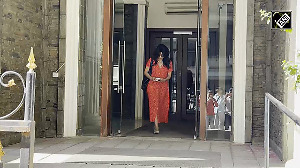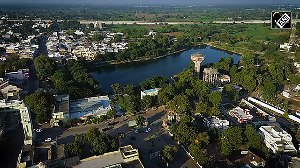Prime Minister Narendra Modi’s visit is an attempt to move the Indo-Singapore relationship to the ‘next level’. Singapore has been one of the top investors in India. India-Singapore bilateral trade has already crossed the $15 billion mark. As per the official records, Singapore has emerged as the second largest source of Foreign Direct Investment in India, says Dr Rahul Mishra.
 After attending the 10th East Asia Summit and the 13th Association of Southeast Asian Nations-India Summit in Malaysia, Prime Minister Narendra Modi begins a two-day visit to Singapore from Monday at the invitation of Singapore’s Prime Minister Lee Hsien Loong.
After attending the 10th East Asia Summit and the 13th Association of Southeast Asian Nations-India Summit in Malaysia, Prime Minister Narendra Modi begins a two-day visit to Singapore from Monday at the invitation of Singapore’s Prime Minister Lee Hsien Loong.
Five ‘S’ are projected by India’s ministry of external affairs as the prime feature of Modi’s visit, namely: Scale up trade and investment; Speed up connectivity; Smart Cities; Skills development; and the State focus. The visit would also include signing the Strategic Partnership Joint Declarationon November 24, to move the bilateral ties to the next level.
The decision to elevate the relationship to a strategic partnershipwas taken during President of Singapore Dr Tony Tan’s visit in February. It may be noted that India already has a strategic partnership with ASEAN, which was signed on December 20, 2012 during the ASEAN-India Commemorative Summit held in New Delhi.
According to the press statement released by Singapore’s ministry of foreign affairs, “the strategic partnership will broaden and deepen ties across various sectors, including defence relations, economic and cultural cooperation, skills development and capacity building.”
During his visit, Modi will also deliver the 37th Singapore Lecture organised by the prestigious ISEAS-Yusof Ishak Institute.
Interestingly, the Chinese President Xi Jinping delivered the 36th Singapore Lecture on November 7. True to his style, Modi would also like to create a ‘Madison square’ or a ‘Wembley stadium’ moment in Singapore when he addresses the Indian community at the ‘Singapore Expo’ on November 24 as the last leg of his two-day visit.
The Indian Diaspora has a strong presence in Singapore, reflected by the presence of Indian-origin ministers in Prime Minister Loong’s cabinet, and also with big business companies such as Infosys, HCL and Tata Consultancy Services registering a strong presence in Singaporean economy. Singapore is a multicultural society, which has embraced the Indian culture as one of its own.
Assimilation of Indian culture in the core of Singapore is indeed a remarkable feat which most of the former British colonies, where Indians had migrated during the British raj and even before, have not been able to achieve yet.
Today, around nine percent population of Singapore comprises people of Indian origin living in Singapore with Tamil is one of the four official languages of the country, a feature seen nowhere else in Southeast Asia.
What makes Modi’s visit even more significant is the fact that this is his “first exclusively bilateral-level official visit in Southeast Asia”. Though Modi had visited Singapore in March to attend the state funeral of Lee Kuan Yew -- the founding father of Singapore, the purpose was to represent India and its people in Singapore’s hour of grief. Though Modi has been to Myanmar (in 2014 to attend 12th ASEAN-India Summit and 9th East Asia Summit) and of course Malaysia during the current trip (to attend 13th ASEAN-India Summit and 10th East Asia Summit), but these were primarily multilateral meetings.
The very fact that he chose Singapore for an exclusive bilateral-level dialogue demonstrates the ‘special importance’ India attaches to Singapore.
The visit is timely as Singapore is celebrating its 50th anniversary as an independent nation in 2015. In 2015, we are also celebrating 50 years of India-Singapore diplomatic relations. In that context, the President of Singapore Dr Tony Tan Keng Yam was on a four-day visit to India from February 8, when he met with President Pranab Mukherjee, Prime Minister Modi and External Affairs Minister Sushma Swaraj.
In October, Singapore's Minister for Foreign Affairs Vivian Balakrishnan visited India to participate in the fourth India-Singapore Joint Ministerial Committee, and also discussed Modi’s Singapore visit.
India’s relations with Singapore are not only time-tested but have also been counted as one of the key partnerships. Back in 1992, when India was trying to find its feet in Southeast Asia through the Look East policy, Singapore played a pivotal role.
As a matter of fact, Singapore became India’s ‘gateway to Southeast Asia’, with the grand success of the ‘India Fever’that it sparked off to economically and diplomatically socialise India in the region.
India has also been a key partner for Singapore. India was one of the first countries to recognise Singapore as a sovereign nation in 1965. The role of the Indian Diaspora has also been very significant in building modern Singapore. For instance, when Sir Stamford Raffles established Singapore (called as Temasek during that time) in 1819, Naraina Pillai, an architect of Indian origin, was assigned the task of building temples in the country.
Under British India, Singapore was ruled from Calcutta. Interestingly, when Subhash Chandra Bose formed the provisional government of Azad Hind Fauj/Indian National Army, Singapore became its capital. To honour the contributions of Bose, INA, and Singapore in India’s struggle for independence, Modi will also lay a wreath at the INA marker in Singapore.
Singapore is arguably the central pillar of India’s Look/Act East Policy in politico-military, socio-economic and strategic terms. With one of the highest bilateral trade volumes in the region, impressive levels of investments, regular bilateral and multilateral joint military exercises the two countries have won each other’s trust and confidence.
Singapore is also the most linked foreign destination with India with around 450 civilian planes shuttling per week between Singapore and a dozen Indian cities. Singapore’s impeccable economic growth, remarkable ease of doing business (ranks No. 1 as per Doing Business Database 2016 released by the World Bank), predominant role of the services sector, strong e-governance, urban management and smart city concept naturally align with Modi’s ‘Make in India’, and ‘Digital India’ campaigns. Notably, India has also improved by 12 points: from 142 in 2014, to 130 in 2015.
Singapore has been one of the top investors in India. India-Singapore bilateral trade has already crossed the $15 billion mark, and is reaching $17 billion. As per the official records, Singapore has emerged as the second largest source of Foreign Direct Investment in India with around $36 billion, while Indian investments in Singapore are also impressive with a $37 billion figure.
Singapore’s strategic location, advanced defence technology, skilled defence personnel and mutual trust make Singapore one of the prime partners in defence cooperation. The components of defence relationship include high-level visits, joint military training, training modules in each other’s military staff/war colleges and other professional exchanges, policy dialogues, and defence production.
While the ST Technology case was a blow to the bilateral defence relations, the two countries have moved on, and are working to strengthen ties in defence procurement and production. So far as bilateral joint exercises are concerned, Singapore tops the list, with India conducting highest number of bilateral exercise with the ‘Lion City’. These have included missions for search and rescue operations and anti-piracy operations.
In essence, Prime Minister Modi’s visit is an attempt to move the Indo-Singapore relationship to the ‘next level’. As Singapore is poised to celebrate the ‘India Fever’ again, as Singapore’s President Dr Tony Tan said in his statement, India needs to rigorously implement the bilateral agreements/MoU signed so far. India can learn a lot from Singapore in urban management and development of smart cities.
The success of Amravati capital (the new capital of India’s Andhra Pradesh) project, the foundation ceremony of which was led by Modi on October 22, would determine the future course of Indo-Singapore cooperation in urban development.
Projects related to water management, sanitation, and traffic control between Singapore and Indian states including Delhi, Rajasthan, Andhra Pradesh and Tamil Nadu should be expeditiously implemented. Additionally, joint ventures in manufacturing sector, vocational training and skill development should also be carefully implemented as they have the potential to complement a strong defence and strategic partnership and bring Indo-Singapore relations to new heights.
Dr Rahul Mishra is Asia Fellow at the East-West Center, Washington, DC.










